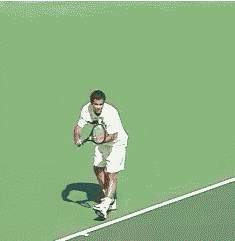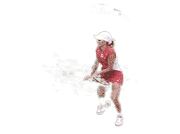
SamprasSecond ServeBy John Yandell
Compare this to the delivery of another top player, such as Andre Agassi. Like Pete, Agassi's second serve is spinning at an average of over 4500rpm, but his average speed is less than 75mph. So how does Pete produce this amazing second ball? He alters the toss slightly moving the contact point further to the left. This in turn changes the way the racquet head approaches the ball. The result is almost twice the spin. After spending seven articles analyzing the interplay of technical elements in his first serve, it may seem strange to devote only one article, the last in the Sampras serve series, to his magical second delivery.
The fact is, we have already in large part analyzed Pete's second serve technique. This is because the major components are almost identical to his first delivery: his incredible racquet drop, his perfect tossing arm motion, the "high five" motion of his hand and racquet to the ball, his full extension at contact, his relaxed, full followthrough, his advanced use of the legs and torso rotation, his "left launch" body angle, and his deceptive ability to vary his placements off a single toss placement. Too many players believe a first serve, a second serve, or for that matter a slice serve, a kick serve, etc, are somehow all fundamentally different, as if they were distinct and unrelated motions. The elements we have examined stay consistent on all of Pete's deliveries. One of the secrets to the consistency of Pete's second serve is that there is essentially only one technical change compared to his first delivery - placement of his ball toss further to the left, and the resulting position of the ball at the contact point, also further to the left. From this ball position, it also appears Pete's racquet approaches the ball slightly further from the left.
As we noted, his ball placement on his first serve is already fairly far to the left compared to other servers, a key component in his "left launch" contact position. If the ball is between the edge of his shoulder and his head on the first serve, it moves about a foot further to his left on the second, so that it is almost directly in line with the center of his head, when viewed from the front. Although the toss is further left, it is important to note it still remains substantially in front of his body. Many players pull the toss back close to or even behind the plane of their bodies on the second serve, gaining spin, but losing speed.
Pete's contact point is still in front of the plane of his body and well out into the court over the baseline. As the two photos show, he is only slightly less forward over the court than on his first serve. The placement of the toss means that to hit with the "high five" motion, Pete's racquet head must approach the ball more from the left side. This shift in the angle of the diagonal on which the racquet approaches the ball is directly responsible for the increase in spin. Click here for Page 2To view the complete Stroke Archives of digitally mastered Pete
Sampras serves,
| ||||||||||||||||||||||
 |
John Yandell is widely acknowledged as one of the leading videographers and students of the modern game of professional tennis. His high speed filming for Advanced Tennis and Tennisplayer have provided new visual resources that have changed the way the game is studied and understood by both players and coaches. He has done personal video analysis for hundreds of high level competitive players, including Justine Henin-Hardenne, Taylor Dent and John McEnroe, among others. In addition to his role as Editor of Tennisplayer he is the author of the critically acclaimed book Visual Tennis. The John Yandell Tennis School is located in San Francisco, California. |
|
Contact Tennisplayer directly: jyandell@tennisplayer.net
Copyright Tennisplayer 2005. All Rights Reserved.










